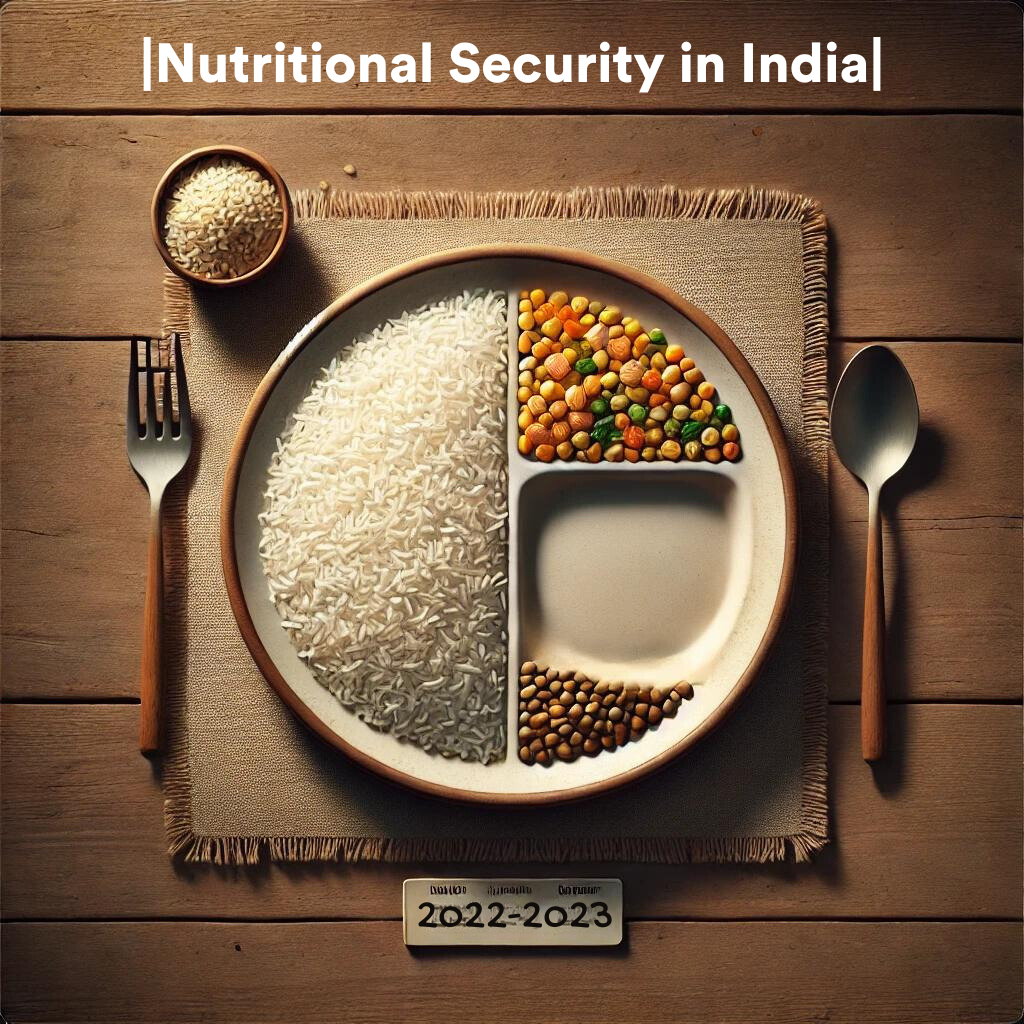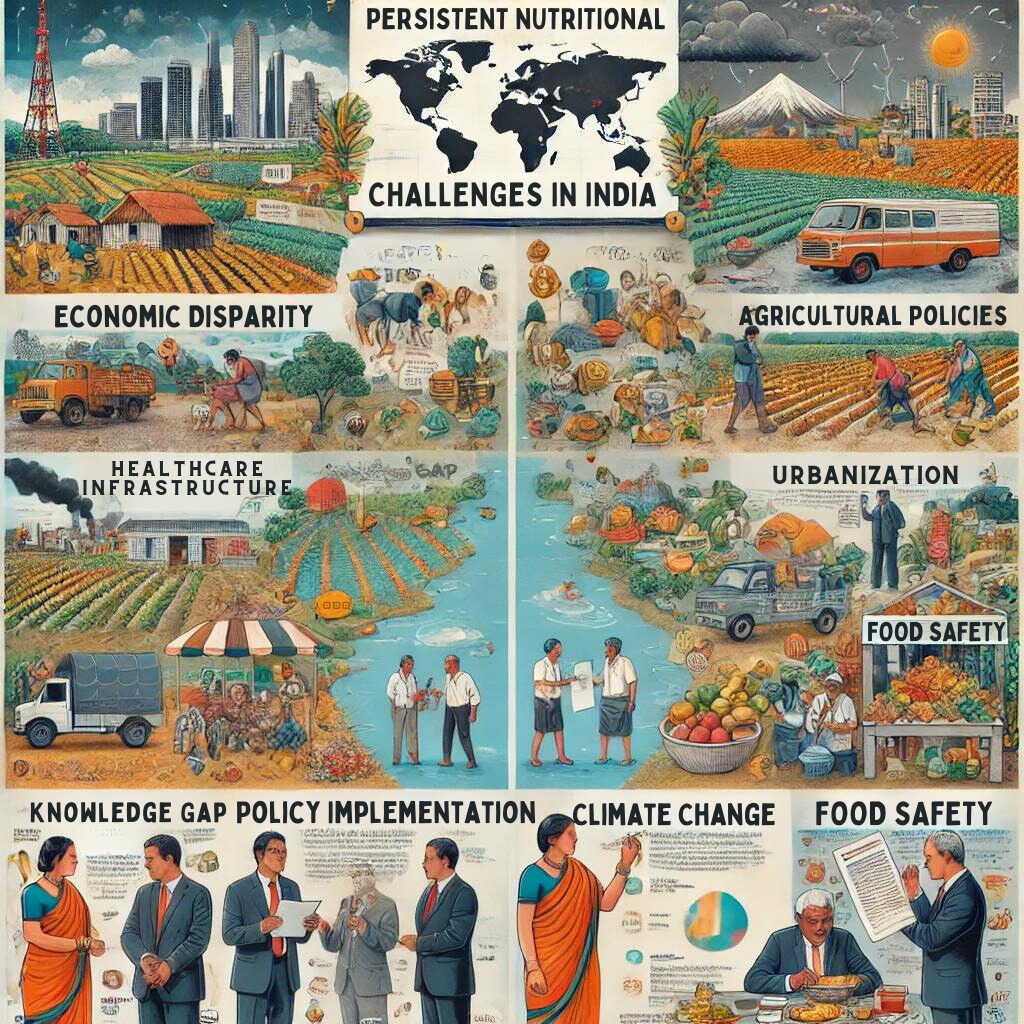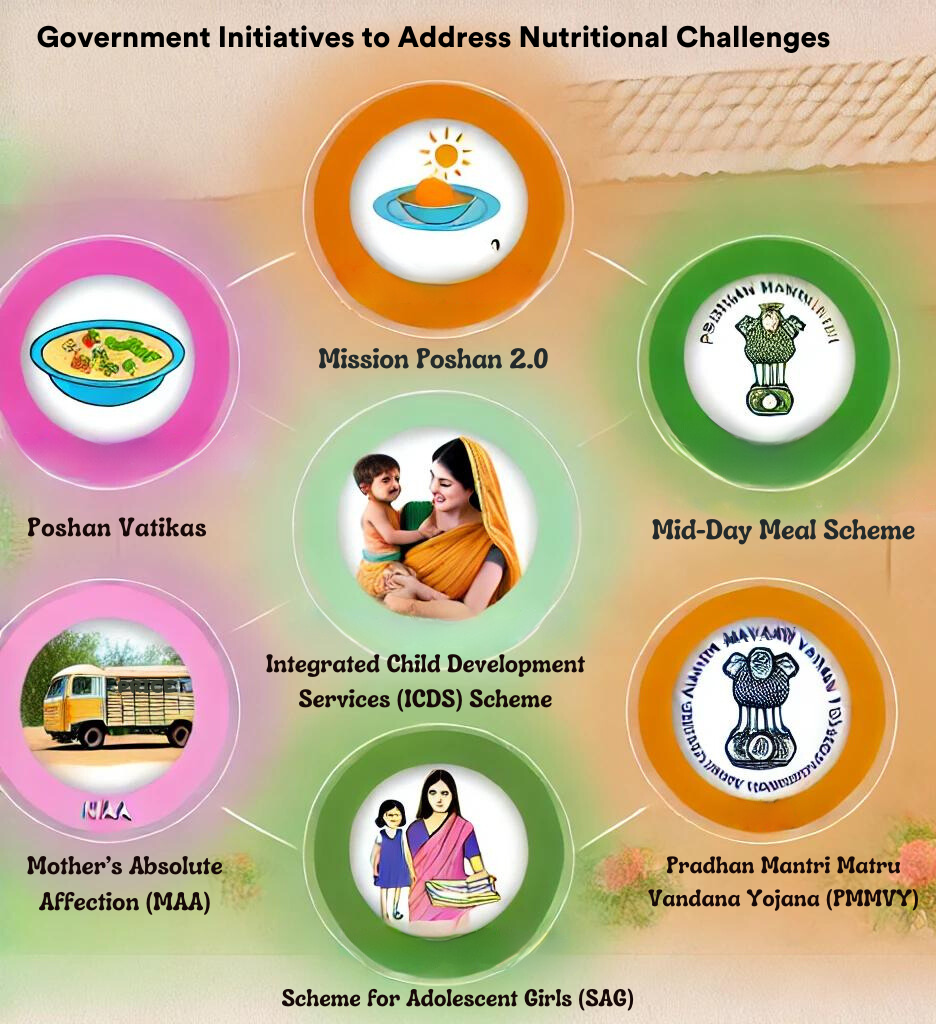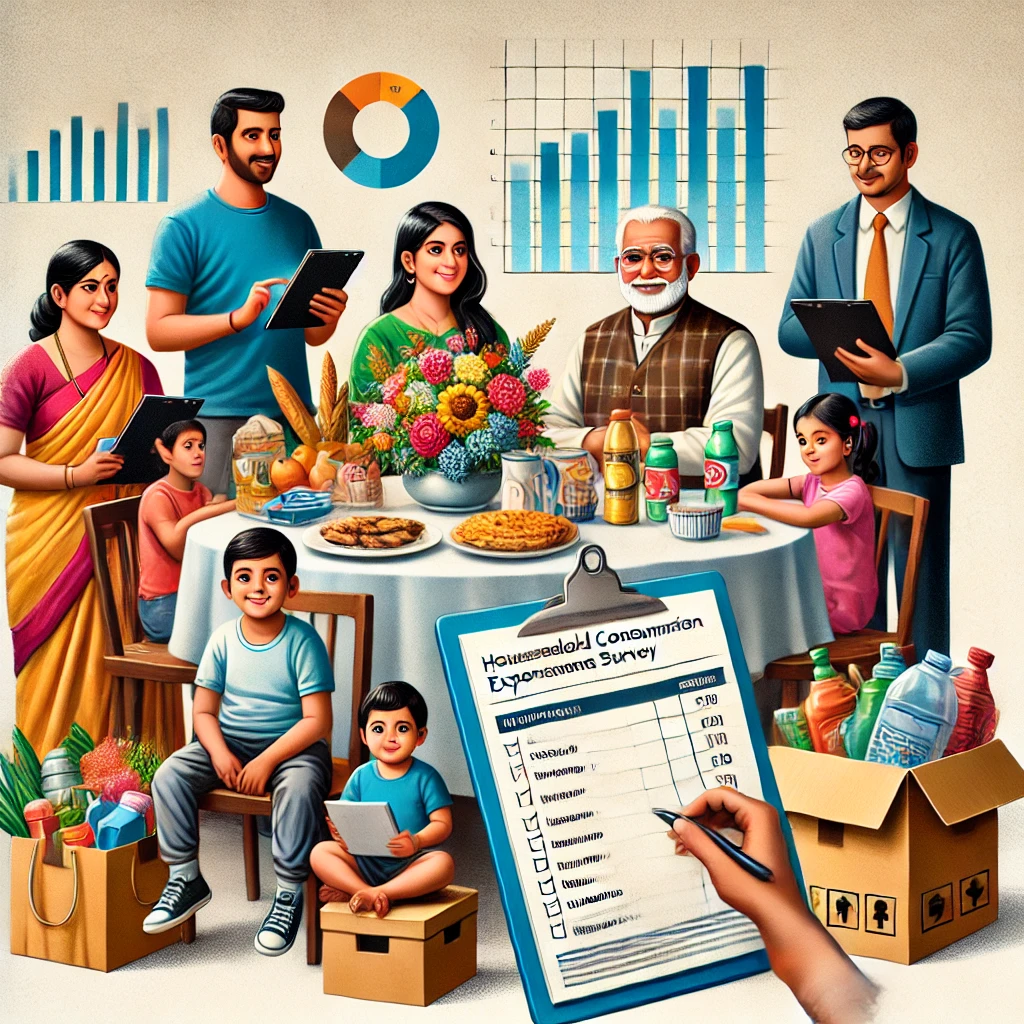The recent Household Consumption Expenditure Survey (HCES) 2022–23 by the National Sample Survey Office sheds light on India’s nutritional challenges. The survey finds that the poorest 10% of the population consume significantly fewer calories than the recommended daily intake, revealing a pressing need for targeted nutritional programs. Despite various government schemes, a large section of India’s population still lacks adequate nourishment, underscoring the need for more focused and effective interventions.
Origin of the Article
This editorial is based on “Counting the ‘poor’ having nutritional deficiency” published in The Hindu on 07/08/2024. The article discusses HCES 2022-23 findings, highlighting calorific intake differences among various expenditure classes and the necessity for better nutritional schemes.
Relevancy for UPSC Students
Understanding India’s nutritional challenges is crucial for UPSC aspirants, as it relates to GS Paper 2 (Issues Relating to Poverty & Hunger, Government Policies & Interventions). Knowledge of these issues can aid in writing essays and answering questions on social justice, public health, and economic development.

Why in News
The findings from the Household Consumption Expenditure Survey (HCES) 2022–23 by the National Sample Survey Office spotlight India’s nutritional deficiencies, especially among the poorest. This data-driven analysis is crucial for UPSC aspirants, connecting with previous questions on poverty, hunger, and government interventions and emphasizing the need for targeted nutritional schemes.
| GS Paper | General Studies II |
| Topics for UPSC Prelims | National Sample Survey Office, Household Consumption Expenditure Survey 2022-23, Nutritional security, World Inequality Report 2022, Global Hunger Index 2023, Global Climate Risk Index 2021, Annual Status of Education Report (ASER) 2022, National Family Health Survey-5, Economic Survey 2023-24, Mission Poshan 2.0, Integrated Child Development Services (ICDS) Scheme, Pradhan Mantri Matru Vandana Yojana (PMMVY, Mid-Day Meal Scheme) |
| Topics for UPSC Mains | India’s Nutritional Challenges, Indian Government Initiatives Related to Nutritional Security. |
National Sample Survey Office’s Household Consumption Expenditure Survey (HCES) 2022-23
The National Sample Survey Office’s Household Consumption Expenditure Survey (HCES) 2022-23 is a crucial tool for understanding India’s nutritional landscape. It offers valuable insights into calorific intake across different expenditure classes, shedding light on the nutritional challenges faced by various socio-economic groups.
Key Findings
The survey reveals significant differences in calorific intake among different expenditure classes. The average daily per capita calorie requirement is 2,172 kcal in rural areas and 2,135 kcal in urban areas. However, the poorest 10% of the population consumes far less, with daily intakes ranging from 1,564-1,764 kcal in rural areas and 1,607 to 1,773 kcal in urban areas.
Poverty Estimation
The HCES 2022-23 estimates poverty levels based on calorie intake and expenditure. The study found that 17.1% of the rural population and 14% of the urban population are classified as “poor” or “deprived.” These estimates take into account both food and non-food expenditures, highlighting the economic challenges faced by these populations.
Need for Targeted Nutritional Schemes
The stark nutritional deficiencies among the poorest segments of society underscore the need for targeted nutritional schemes. While existing welfare programs aim at food security, there is a pressing need for specific initiatives to improve the nutritional status of the most vulnerable populations, enabling them to lead healthier lives.
What is Nutritional Security?
Nutritional security is a state where individuals have access to adequate, safe, and nutritious food that meets their dietary needs and food preferences for an active and healthy life. It goes beyond food availability to include the quality and utilization of food for maintaining good health.
Concept and Scope
Nutritional security encompasses access to a variety of safe and nutritious foods that meet dietary needs and preferences. It ensures that individuals not only have enough food but also the right types of food to lead active and healthy lives, addressing both quantity and quality.
Why is Nutritional Security Necessary Alongside Food Security?
Nutritional security is crucial for achieving holistic health outcomes, economic productivity, cognitive development, and resilience to diseases. It complements food security by focusing on the quality and diversity of nutrients consumed.
Holistic Health Outcomes
Nutritional security emphasizes nutrient quality and diversity. While food security ensures sufficient calorie intake, nutritional security addresses the need for a balanced intake of macro and micronutrients, essential for optimal health outcomes.
Economic Productivity
Nutritional security is linked to economic productivity. Malnutrition reduces work capacity, increases healthcare costs, and impacts GDP. Ensuring nutritional security fosters a more productive workforce and reduces the healthcare burden.
Cognitive Development and Education
Proper nutrition, especially in early childhood, is vital for cognitive development and educational outcomes. Adequate nutrition in the first 1,000 days leads to higher IQs, better school performance, and improved earning potential.
Resilience to Diseases
Nutritional security enhances resilience to diseases. A well-nourished population is better equipped to fight infections and recover from illnesses, making it a key public health strategy, particularly evident during the COVID-19 pandemic.
Biodiversity and Nutrition
Promoting nutritional security supports biodiversity conservation. Encouraging dietary diversity fosters the cultivation and consumption of a wider variety of foods, improving nutritional outcomes and enhancing agricultural biodiversity and ecosystem resilience.
Why does India Persistently Face Nutritional Challenges?
Despite various efforts, India faces persistent nutritional challenges due to economic disparity, the mixed legacy of the Green Revolution, climate change, and other factors.

Economic Disparity: The Wealth-Nutrition Gap
Economic inequality translates to nutritional inequality. The top 10% of Indians hold 57% of the national income, leading poorer households to rely on cheap, calorie-dense foods, resulting in significant nutritional disparities.
The Green Revolution’s Mixed Legacy
The Green Revolution prioritized staple crops like wheat and rice, leading to micronutrient deficiencies. Recent initiatives like millet promotion are steps forward, but comprehensive agricultural policy changes are needed for nutritional diversity.
Climate Change: The Looming Threat to Nutritional Security
Climate change affects crop yields and food prices, making nutritious diets unaffordable for vulnerable populations. Erratic weather patterns and rising temperatures pose significant threats to food security and nutrition in India.
The Knowledge Gap
Despite improved literacy rates, nutritional awareness remains low. Lack of knowledge about balanced diets and proper feeding practices contributes to poor nutritional outcomes, highlighting the need for enhanced nutritional literacy.
Healthcare Infrastructure: The Missing Link in Nutrition
India’s healthcare system, especially in rural areas, struggles with nutritional interventions. The Covid-19 pandemic exposed these weaknesses, indicating the need for better healthcare infrastructure to support nutrition.
Urbanization: The Double-Edged Sword
Urbanization presents both opportunities and challenges for nutrition. While urban areas offer diverse food options, they also face issues like food deserts and unhealthy lifestyles, impacting public health and productivity.
Policy Implementation: The Gap Between Intent and Impact
Although India has nutrition-focused policies, implementation often falls short due to bureaucratic inefficiencies. Programs like Poshan Abhiyaan face challenges in fund utilization and coordination among government departments.
Food Safety and Quality: The Overlooked Dimension
Food safety issues like adulteration and contamination reduce the nutritional value of food. Ensuring food safety is crucial for improving nutritional outcomes and public health in India.
Food Loss and Waste
India loses a significant portion of its food production due to inadequate storage and transportation. Reducing food loss and waste is essential to making nutritious diets more affordable and accessible.
Government Initiatives to Address Nutritional Challenges
The Indian government has launched several initiatives to tackle nutritional challenges, aiming to improve the nutritional status of the population.
Mission Poshan 2.0
Mission Poshan 2.0 integrates various nutrition initiatives to address malnutrition. It focuses on a holistic approach to improving nutritional outcomes for children, pregnant women, and lactating mothers.
Integrated Child Development Services (ICDS) Scheme
The ICDS scheme aims to improve child development and nutritional services. It provides food, preschool education, and primary healthcare to children under six and their mothers.
Pradhan Mantri Matru Vandana Yojana (PMMVY)
PMMVY promotes maternal health by providing cash incentives to pregnant and lactating women. This scheme aims to improve maternal and child health outcomes by ensuring adequate nutrition.
Mid-Day Meal Scheme
The Mid-Day Meal Scheme provides nutritious meals to school children, aiming to improve their nutritional status and encourage school attendance. It plays a crucial role in addressing child malnutrition.
Scheme for Adolescent Girls (SAG)
SAG focuses on the nutritional support and education of adolescent girls. It aims to improve their health, education, and overall well-being, addressing the specific nutritional needs of this vulnerable group.
Mother’s Absolute Affection (MAA)
The MAA program promotes breastfeeding and maternal health. It aims to ensure that infants receive the best nutrition through breastfeeding, improving their health and development.
Poshan Vatikas
Poshan Vatikas are community nutrition gardens that promote the cultivation of nutritious foods. These gardens engage communities in improving their nutritional status through locally grown produce.

Measures to Bridge the Nutrition Gap
To address the nutrition gap in India, several measures can be adopted, including integrating nutrition into social safety nets, implementing targeted programs, and promoting nutritional awareness.
Nutrition-Integrated Social Safety Nets
Integrating nutrition into social welfare programs can enhance their effectiveness. Expanding the Public Distribution System (PDS) to include nutrient-rich foods and incorporating nutrition education can improve nutritional outcomes.
Targeted Nutrition Coupon Program
A targeted nutrition coupon program can provide customized food coupons to malnourished individuals, allowing them to access nutrient-rich foods. This approach empowers beneficiaries to make healthier food choices.
Transforming Educational Institutions into Nutrition Hubs
Schools can be transformed into nutrition hubs by providing balanced meals, establishing school gardens, and integrating nutrition education. This holistic approach can improve children’s nutritional status and educational outcomes.
Nutri-Preneur Program
Supporting nutrition-focused entrepreneurs through a Nutri-Preneur program can drive innovation in fortified foods and nutrition testing kits. Providing funding and mentorship can foster a thriving nutrition sector.
Behavioral Economics for Nutrition
Applying behavioral economics can nudge people towards healthier food choices. Redesigning food packaging and creating public health campaigns can make nutritious eating more appealing.
Integrated Nutrition Surveillance System
An integrated nutrition surveillance system can collect real-time data on nutritional indicators, enabling rapid responses to nutritional challenges. This system can leverage existing health infrastructure for data collection and analysis.
Fortification Plus: Enhancing Staple Foods
Expanding food fortification programs can improve nutritional intake without altering dietary habits. Fortifying staple foods with essential micronutrients can address widespread deficiencies.
Nutri-Smart Agriculture
Incentivizing farmers to cultivate nutrient-dense crops through a Nutri-Smart Agriculture initiative can enhance nutritional diversity. Supporting biofortified crops and market linkages can improve agricultural and nutritional outcomes.
Community Nutrition Champions
Establishing a network of Community Nutrition Champions can promote nutrition education and awareness at the grassroots level. These trained volunteers can conduct sessions and provide personalized nutrition counseling.
PESTEL Analysis
| Political: India’s government has initiated several programs to improve nutritional security, such as Mission Poshan 2.0 and the Integrated Child Development Services. However, challenges in policy implementation and bureaucratic inefficiencies hinder effective delivery. Economic: Economic disparities significantly impact nutritional security, with poorer households struggling to afford nutritious diets. Improving economic conditions and integrating nutrition into social safety nets can help address these disparities. Social: There’s a crucial need to raise awareness about the importance of nutrition. Urbanization also presents challenges such as the prevalence of processed foods and food deserts in densely populated areas, affecting diet diversity. Technological: Technological interventions can support the surveillance of nutritional statuses and promote Nutri-Smart agriculture, helping produce diverse, nutrient-dense crops. Additionally, technological advancements can improve food safety and reduce food loss. Environmental: Climate change affects crop yields and food prices, directly impacting the affordability of nutritious diets. Promoting agricultural resilience and biodiversity can help mitigate these impacts. Legal: Food safety regulations need to be enforced to ensure that adulteration and poor handling practices do not undermine food quality. Legal frameworks should support and enforce the implementation of nutrition-related policies more effectively. |
Conclusion
In conclusion, addressing India’s nutritional security is not just a health imperative but an economic and social necessity. While existing policies have laid the groundwork, bridging the nutrition gap requires innovative, targeted, and integrated approaches. UPSC aspirants must critically analyze these multi-faceted challenges and envision robust solutions to ensure that every Indian has access to adequate, safe, and nutritious food, fostering a healthier and more productive nation.
| UPSC Civil Services Examination, Previous Year Questions (PYQs) Mains Q. What are the major impediments to marketing and supply chain management in developing the food processing industry in India? Can e-commerce help in overcoming these bottlenecks? (GS Paper III, 2015). Q. Analyze the effectiveness of government initiatives like Mission Poshan 2.0 and the Integrated Child Development Services (ICDS) Scheme in tackling malnutrition in India. What improvements can be suggested to enhance their impact? |


